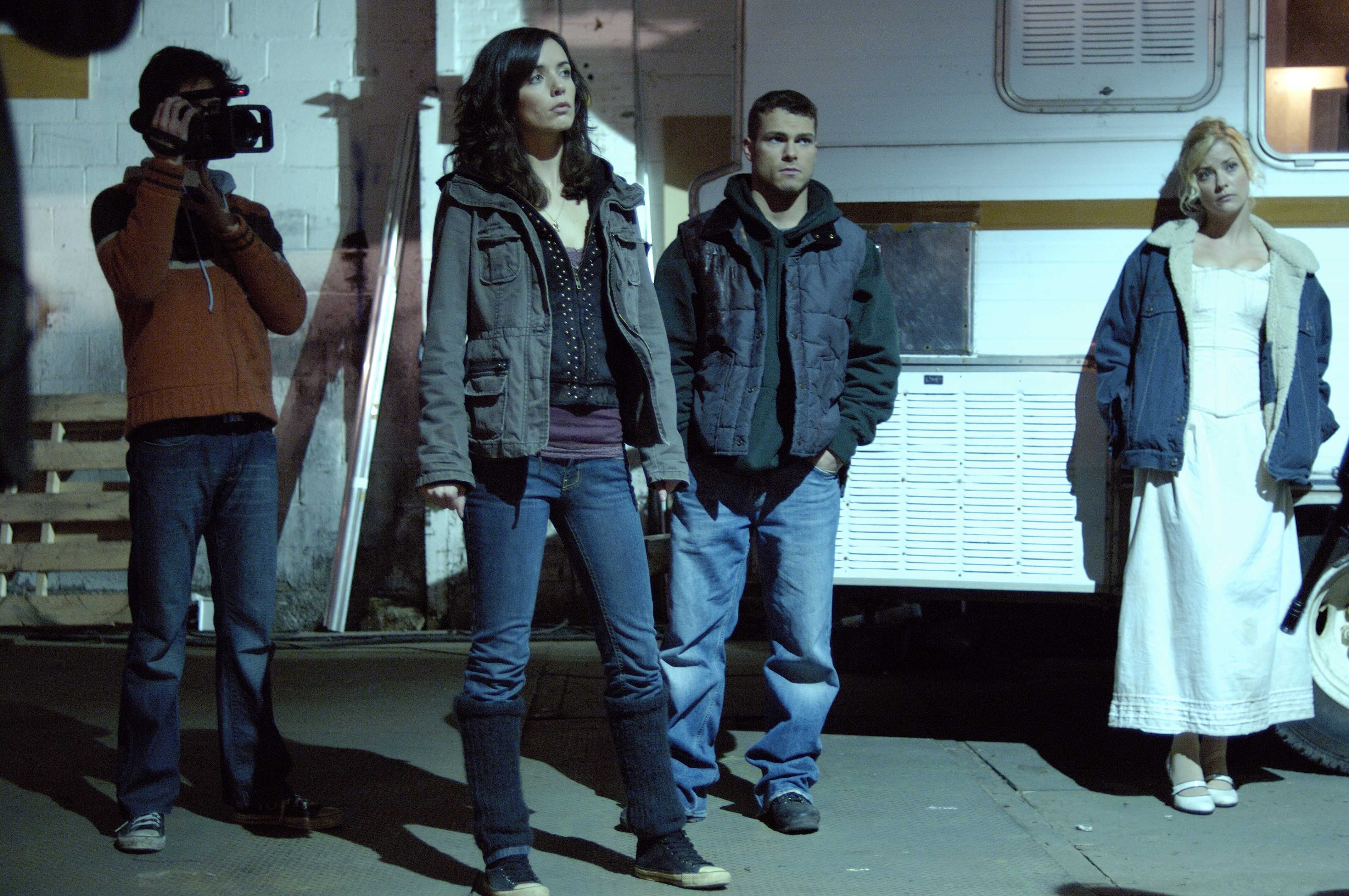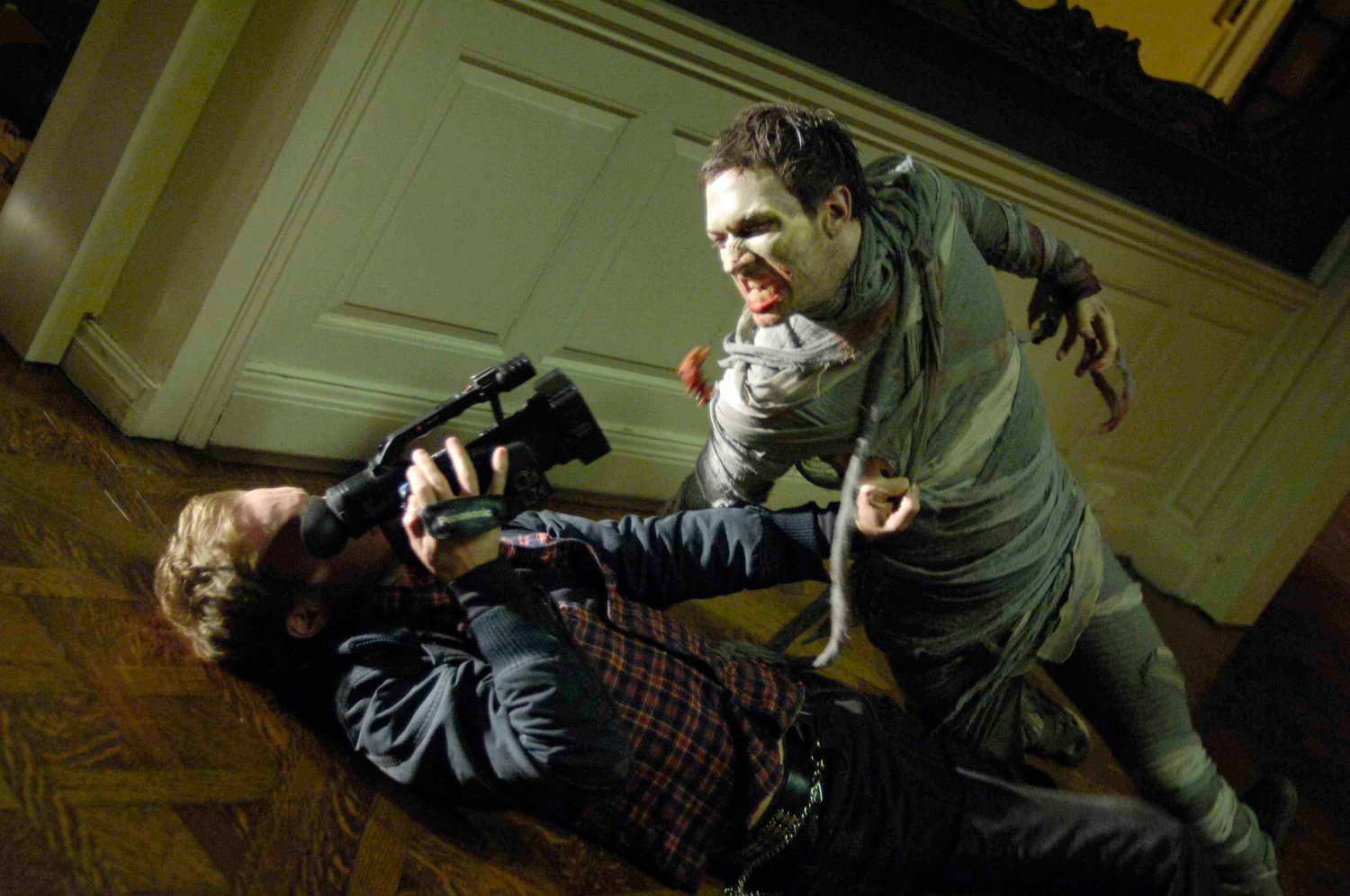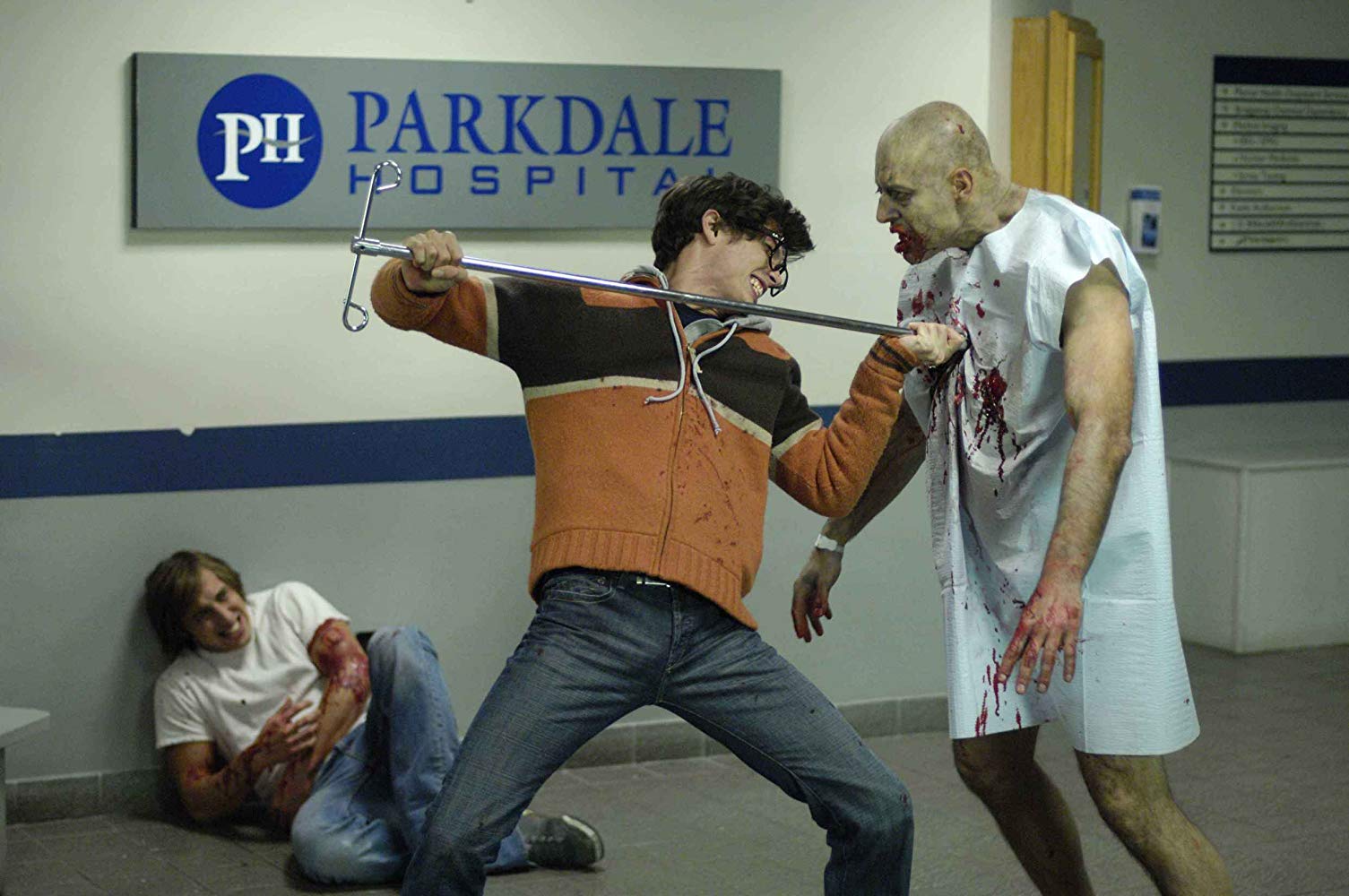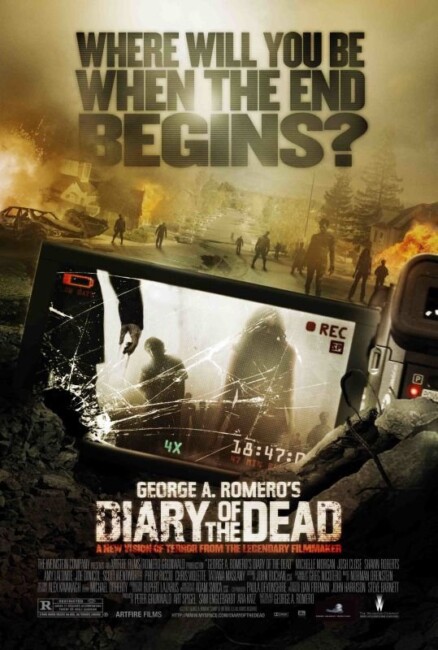USA. 2007.
Crew
Director/Screenplay – George A. Romero, Producers – Sam Englebardt, Peter Grunwald, Ara Katz & Artur Spigel, Photography – Adam Swica, Music – Norman Orenstein, Visual Effects – SpinVFX (Supervisors – Jeff Campbell & Colin Davies), Special Effects Supervisor – Mark Ahee, Makeup Effects – Gaslight Studio (Supervisors – Chris Bridges, Kyle Glencross & Neil Morrill), Production Design – Rupert Lazarus. Production Company – Artfire Films/Romero-Grunwald/George A. Romero’s Diary of the Dead LLC.
Cast
Michelle Morgan (Debra Moynahan), Josh Close (Jason Creed), Scott Wentworth (Professor Andrew Maxwell), Shawn Roberts (Tony Rebello), Amy Lalonde (Tracy Thurman), Joe Dinicol (Eliot Stone), Chris Violette (Gordo Thorsen), Philip Riccio (Ridley), Tatiana Maslany (Mary Dexter), R.D. Reid (Samuel), Martin Roach (Stranger)
Plot
A group of film school students at the University of Pittsburgh are shooting a horror film when news comes of people rising from the dead. The director Jason Creed picks up his girlfriend Debra Moynahan and they set out in an RV to her family’s home in Scranton, along with most of the film crew. Jason insists on filming everything with his video camera as a record of what is happening. Along the way, they see the dead coming to life and devouring the flesh of the living. As society starts to collapse around them, Jason struggles to film what is happening and upload his finished film to the internet.
George Romero is a genre legend. The Romero legend rests principally on his Dead films, beginning with his first film Night of the Living Dead (1968). Night of the Living Dead changed the face of horror in a number of ways – it stripped away the conventions that horror operated on, it brought horror away from the studios to independent success and was the first horror film to become a midnight cult favourite. Night of the Living Dead also introduced George Romero’s penchant for biting social commentaries – the film was seen as a satire on Vietnam.
A decade later Romero returned to zombies with Dawn of the Dead (1978), which became just as much of a cult classic as its predecessor. Both films were very different works in that Dawn of the Dead was in colour, Romero had turned his zombies into comic figures and the underlying metaphor was a biting attack on the consumer society. Romero returned to zombies not long after with Day of the Dead (1985), a brilliantly underrated film that contains some of Romero’s finest writing. Alas, Day of the Dead was not a success and Romero was forced to compromise his original vision. The decade-and-a-half ahead was not a good one for George Romero with a series of non-starter projects or films that emerged with middling results. (A full list of George Romero’s films is at the bottom of the page).
That would probably have been the last we heard of George Romero’s Dead saga. However, a funny thing then happened. The early 00s brought a sudden spate of renewed interest and/or homages to Romero’s zombie films. First there was the likes of Resident Evil (2002), 28 Days Later (2002) and House of the Dead (2003), which substantially homaged Romero, and this was followed by the successful remake of Dawn of the Dead (2004). This inspired an industry of films cashing in on the George Romero name/connection – other remakes like Night of the Living Dead 3D (2006), Day of the Dead (2008) and Night of the Animated Dead (2021); spinoffs like Day of the Dead 2: Contagium (2005), Return of the Living Dead: Necropolis (2005), Return of the Living Dead: Rave to the Grave (2005), Night of the Living Dead Reanimated (2009), Night of the Living Dead: Resurrection (2012), Night of the Living Dead: Darkest Dawn (2015), Night of the Living Dead: Genesis (2016), Night of the Living Dead: Rebirth (2017) and Day of the Dead: Bloodline (2018); and spoofs like Shaun of the Dead (2004), as well as a mountain of other mostly low-budget zombie films. [Indeed, only a month before Diary of the Dead was released there was another entire zombie Found Footage film made with the Spanish [Rec] (2007)]. Amid this renewed interest, Romero found the funding to make a return with Land of the Dead (2005), which rounded off his vision of the Dead saga that he was unable to make in 1985. Land of the Dead was a somewhat weak return, although not without its moments and still had the good old Romero biting social commentary.

Diary of the Dead was a further entry in George Romero’s zombie series. Romero, always an independent filmmaker who worked outside the Hollywood system, had found increasing difficulty over the years finding funding to make his films – a substantial part of the reason his output was so sporadic in the 1990s. With Diary of the Dead, Romero, now in his late 60s, relocated to Toronto and made the film with an unknown cast, shooting on digital video and with a budget of only $2 million (which it should be noted is 14 times less than the Dawn of the Dead remake).
Diary of the Dead is George Romero smartly reinventing his zombies for the 00s. This is a zombie film that sits among the era of the camcorders, digital piracy, cellphone cameras, the blogosphere, My Space and YouTube, all of which are referenced throughout. Aside from the quantum shift in the mode of media that surrounds it, the film itself has been shot on digital video. Moreover, George Romero has made Diary of the Dead as a Found Footage film where everything is filmed by a handheld camera supposedly being carried by someone in the midst of the action. [Diary of the Dead went into general release in the US a month after Cloverfield (2008), which likewise used the Found Footage approach to make a monster movie].
Romero does cheat within the Found Footage format to make Diary of the Dead a more commercial film. As Michelle Morgan amusingly notes in her voiceover introduction “I’ve added music occasionally for effect, hoping to scare you.” Romero also improbably has various of the actors using secondary or cellphone cameras in order to cut his single camera point-of-view up. At one point, Michelle Morgan comes across Josh Close cutting in footage from cctv cameras at the hideout simply so that Romero can include external shots of the vehicles arriving. (If nothing else, you have to complement George Romero on the rigorousness of keeping to the logic of the Found Footage camera). Neither [Rec] nor Cloverfield cheated as much on the first person camera logic; on the other hand, George Romero is far more challenging in the way that he constantly interrogates the role of the filmmaker, asking to what extent the documentary cameraman is complicit in the activities he is filming – Josh Close is seen as having blood on his hands, while his determined obsession to finish the film is seen as placing the others into danger.

Like most of George Romero’s catastrophe films, Diary of the Dead is bitingly satiric. We get anonymous voices on the radio commenting: “We become hysterical about all these people crossing the border into our country. But that’s not the problem anymore. The problem’s people crossing the border between life and death.” There are also the scenes where the party comes across a group of African-American men led by Martin Roach who have taken the opportunity to arm themselves and set up their own fortress. “What’s with you?” Josh Close asks, “Why did you stay?” As Roach explains: “Because we got the power. For the first time in our lives, we got the power because everybody else left. All the folks without suntans,” where you can clearly see this it is Romero spinning the zombie film by way of the racial disparities brought out by the Hurricane Katrina disaster.
The ending of Diary of the Dead revisits the ending of Night of the Living Dead, showing hicks shooting zombies for fun, including one haunting scene where a female zombie is strung up to a tree by her hair and her body shot away as Michelle Morgan comments in voiceover: “Are we worth saving? You tell me.” It shows a George Romero who has becomes deeply pessimistic about any hope for the human condition.
Mostly, Diary of the Dead is about the issue of independence in the modern media. The film opens with a network news tape of a zombie attack and later we see a government spokesperson trying to dismiss the event as merely a fracas between immigrants. Compare this to the news broadcast about the returned satellite in Night of the Living Dead – here television is no longer a disseminator of information but a tool of government spin. Romero sees that truth is a commodity that has become lost in the complicity between government, the media and commercial interest. As Michelle Morgan notes in one of her voiceovers: “The more voices there are, the truth becomes that much harder to find. It all just becomes noise.” Romero sees the only unadulterated truth lies out there in the freedom of the blogosphere and the film is in effect about the heroic struggle to tell the truth free of mainstream lies. “The mainstream had vanished. It was just us – bloggers, hackers, kids,” comments Michelle Morgan.
Diary of the Dead is George Romero going back to basics and doing what Romero does best and delivering the goods. The low-budget, digital-shot look seems to have greatly freed Romero from the fog that affected his films throughout the 1990s. The low key approach is never better demonstrated than the opening scenes where Romero shows a great deal of directorial sophistication in having a number of things – arriving paramedics, fussing news presenters and the dead returning to life and coming after the living – all within the space of a single sustained shot. There is an enormous amount of creativity to Diary of the Dead. One of the most inventive touches is that of Samuel the deaf Amish zombie hunter – it is a genuine shame that he ended up being disposed of so quickly as this is one of the most original characters in the Dead series.

George Romero also takes the opportunity to return to the trademark gore that was a feature of the original Dawn of the Dead and Day of the Dead but became watered down by the time of Land of the Dead. We get various scenes with a zombie rolling off a hospital bed and its intestines falling out; the novelty of seeing a zombie’s skull and brain melt down after acid is thrown on its head; a head bifurcated by a sword; and the climactic scene where a female zombie is hung from a tree by its hair and the body blown away leaving only the top half of the head still hanging. It feels after several years in limbo that Groege Romero has finally found himself him again and Diary of the Dead is an authentic showing of the good old Romero goods.
Less successful is Romero’s attempts to carp at horror cliches during the shooting of a low-budget horror film with Amy Lalonde, playing a heroine horror being pursued by a mummy, interrupting shooting to ask why heroines in horror films always have to have low necklines, twist their ankles and get their tops ripped off by the monster. Romero clumsily revisits the scene later in the film where the zombified Philip Riccio, still wearing his mummy costume, pursues Amy Lalonde for real, tearing her top off and she tripping and falling, while Josh Close futilely stands over trying to yell “cut”. It is one of the Diary of the Dead‘s few moments of humour but feels like a joke that could have easily ended on the cutting room floor.
George Romero conducted a sequel with Survival of the Dead (2009) where Alan Van Sprang who plays the minor role of a fake soldier who invades the RV is expanded to become the central character.
George Romero’s other genre films include:– Night of the Living Dead (1968); Jack’s Wife/Season of the Witch/Hungry Wives (1972) about suburban witchcraft; The Crazies (1973), an underrated film about a madness-inducing biospill; The Amusement Park (1975), a surreal allegory about aging; Martin (1976), a superb deconstruction of the cinematic vampire myth; Dawn of the Dead/Zombies – Dawn of the Dead (1979); the Stephen King horror comic homage Creepshow (1982); Day of the Dead (1985); Monkey Shines (1988) about a psychic link between a paraplegic and a murderous monkey; Two Evil Eyes (1990), an Edgar Allan Poe collaboration with Dario Argento; The Dark Half (1993), from the Stephen King novel about a writer haunted by an evil doppelganger; Bruiser (2000) about a man whose face suddenly becomes a blank mask; and Land of the Dead (2005). Romero has also produced the Tales from the Darkside (1983-5) and Monsters (1988-9) horror anthology series, as well as the films Deadtime Stories (2009), Deadtime Stories 2 (2010) and the remake of The Crazies (2010). His scripts include Creepshow II (1987), Tales from the Darkside: The Movie His scripts include Creepshow II (1987), Tales from the Darkside: The Movie (1990) and the remake of Night of the Living Dead (1990). Also of interest is George A. Romero’s Resident Evil (2025), a documentary about Romero’s unmade Resident Evil film.
Trailer here


